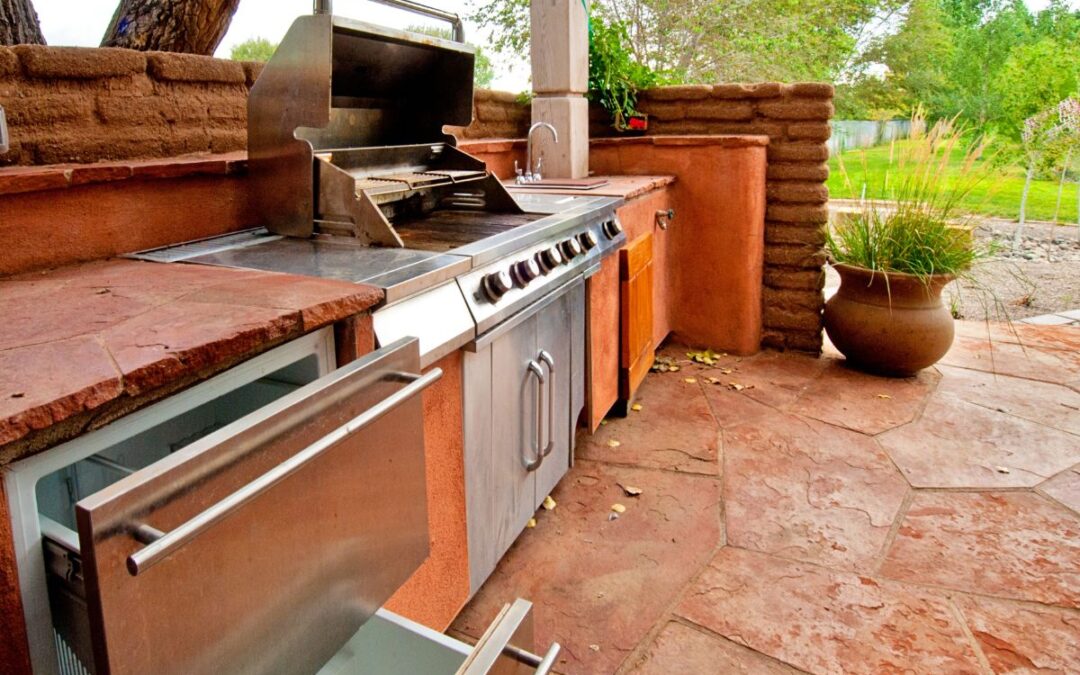When it comes to outdoor kitchens, there are a lot of materials you can choose from to build the kitchen’s body and countertops. While you shop around, you need to consider a bunch of factors for each material like durability, cost, and style.
Concrete outdoor kitchens are very distinctive and if you are looking for a modern, industrial outdoor kitchen, it could be an ideal material for your designs – but what can you do with it? Here, we have compiled a list of some high quality concrete outdoor kitchens for you to look at and admire.
This may give you some inspiration for designing your own concrete outdoor kitchen or help you see what kind of specific styles concrete can achieve. Alternatively, you may find that concrete isn’t what you want for your outdoor kitchen.
No matter what, check out the concrete outdoor kitchens below to discover more styles, designs, and opportunities for your outdoor kitchen!
1. Built-In Concrete Wall Outdoor Kitchen
What makes this design stand out is how the counters blend seamlessly with the concrete call supporting the kitchen. This wall can be used to hang lighting and storage shelves – or leave it plain for a smooth, modern design!
2. Minimalist Concrete Counters
This creates a seamless minimalistic design and provides you with enough space to stack wood for your grill or pizza oven. The minimalism of the kitchen makes it appear modern and industrial, which is great for similarly designed homes.
There are no bells or whistles here – just a sturdy, honest kitchen counter for your prepwork.
3. Sleek And Modern Concrete Kitchen Area
With most outdoor kitchen materials, they create patterns in the body of the cabinets and kitchen countertops. For example, bricks or wooden panels all feature patterns – but for a truly modern kitchen, cutting back on patterns is a great way to truly capture this theme.
Concrete is great for this. It can be poured into shape and set to harden, leaving no visible patterns in the counters and cabinet bodies. This creates a really sleek, flawless design that is perfect for very modern and minimalist kitchens.
If you are greeting a long outdoor kitchen area, then concrete can help unify it all together and create one smooth, consistent design.
4. Rustic Concrete Outdoor Kitchen
Concrete kitchens can also be used to create bare, rustic outdoor cooking spaces.
When combined with more rustic elements, like loose stone walls, plants, bare brick flooring, woven baskets and clay pots, straw or wooden awnings, it can create an outdoor kitchen that looks more traditional than new and modern.
The type of concrete you use and the color of it can make an impact on just how rustic it will look. Not only did this example use a darker concrete and seal, but left the concrete to try so it looked more patchy and imperfect – a big contrast to the smooth concrete surfaces seen in modern kitchens.
5. Cubist Concrete Outdoor Kitchen
This outdoor kitchen area takes the minimalist style and dips into cubism architecture. With strong straight edges and sharp corners, this outdoor kitchen perfectly mimics the cubist architecture style. This means that it offers an extreme minimalist area that lacks a lot of the details and features you see with a majority of outdoor kitchens.
This includes no kitchen cabinets, lighting, or hooks to store your accessories and equipment – it’s a grill, a sink, and some prep space. The top also functions as a bar so it’s more versatile that it may first seem.
6. Open Concrete Kitchen Shelving
This concrete outdoor kitchen is fairly minimalistic and is designed to look like a series of long shelves rather than kitchen bodies with cabinets, etc.
As a result, it’s fairly simplistic but offers a lot of prep area and storage space. You can even fit your grill or smoker in the shelving with ease so all of your kitchen space is pushed into one area, leaving most of your backyard open for sitting, lounging, and other activities.
So, if you are using a built-in pizza oven or just have a long wall in your backyard that looks empty, you can add a concrete kitchen area styled into a series of floating shelves!
7. Concrete Brick Outdoor Kitchen
Concrete can be turned into large slabs and these can be used to build the body of your outdoor kitchen. This is a great idea if you like the design and pattern of brick-built outdoor kitchens but want to use a more modern, sleek type of brick.
Concrete is perfect for this and can be used to create a flawless kitchen base that is smooth, modern body for your kitchen.
8. True Concrete Outdoor Kitchen
A lot of concrete kitchens can look cold and totalitarian due to the sharp edges, angles, and corners used in their construction. However, concrete can be used to create softer outdoor cooking spaces – like with this great example.
By using rounded edges and a concrete that uses an efflorescent-effect (it looks as though it is covered with a chalky white substance but in reality is smooth to touch and cook upon), the overall kitchen looks more welcoming.
Add a few plants, match the gray with a pastel color or two, and you will have a cute little outdoor kitchen that is balanced between modern and traditional styles.
9. Concrete And Wood Kitchen Combo
You don’t have to stick with using just concrete to build your kitchen. Adding other materials to your outdoor kitchen can change its style and help it complement the rest of your backyard and home.
One popular material to use is wood. Wood can be used to hide your cabinets or serve as a backdrop to the counters. This works especially well if you already have a wooden canopy over your kitchen space – it can blend the two together effortlessly.
10. Just The Countertops
Not all concrete kitchens use concrete to make the foundations and bases of every part of the kitchen. Instead, some kitchens only use concrete for the kitchen countertops. This provides a nice contrast to the materials you use for the kitchen’s main body.
This example uses stone bricks so there’s a cohesive theme, but the stone adds a more rustic quality to the kitchen, giving it more warmth and better suited for traditional styled homes. The concrete countertops, however, are smooth and modern and practical. This allows you to create a versatile kitchen that blends different styles to make something unique!
Final Thoughts
And that’s it! Those were 10 high quality concrete outdoor kitchens that you can take inspiration from!
As you can see, there are a lot of things you can do with a concrete outdoor kitchen. There are plenty of modern styles and designs you can either copy exactly or use as a basis for your own personal designs. Either way, using concrete to build your outdoor kitchen can help you achieve an amazing outdoor cooking area for you to love. We hope this guide helped you out!
Frequently Asked Questions
Is Concrete Good For Outdoor Kitchens?
Absolutely!
Concrete offers outdoor kitchens a ton of unique benefits compared to other materials. One of the most obvious is durability – you’re going to have a tough time ruining your kitchen countertops when they are made of concrete.
Another great benefit is that it can fit your outdoor kitchen’s dimensions exactly. With other materials, you need to shape, cut, and bend materials to try and get the exact shape you want or need for your outdoor kitchen.
With concrete, you just pour it in and it will easily fit into any space you have.
What Are The Disadvantages Of Concrete Kitchens?
Nothing is perfect and you should always be aware of the disadvantages of each outdoor kitchen counter material. While concrete has its advantages, it also has a few disadvantages you need to consider before opting to use it yourself.
The first disadvantage is chipping and staining. These are common issues for all stone surfaces and you will need to put a lot into maintaining your concrete kitchen countertops to keep the surface free from cracks, stains, scratches, and chips.
Secondly, concrete is porous. Most concrete kitchens need to be sealed to avoid any bacteria growing from spilled liquids – so you also need to find a good sealer, or you could face some serious issues once your kitchen is in use.
These don’t mean you should dismiss having a concrete outdoor kitchen yourself – but you need to weigh up your options to find the right material for you and your outdoor kitchen.

